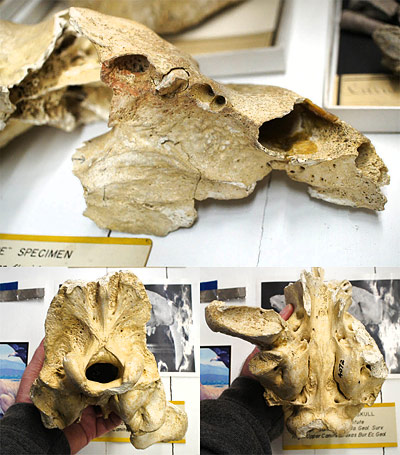It suggests that the prehistoric predators might have been able to feed on even the most giant prey of the Pleistocene era.
Credit…Aldo Manzuetti

When the curator mentioned a huge saber-toothed tiger skull stored behind the scenes of the National Museum of Natural History in Montevideo, Uruguay, Aldo Manzuetti had to see for himself.
The skull belonged to Smilodon populator. Extinct for about 10,000 years, the heavily muscled species once Hulk-smashed its way through South American fauna in the Pleistocene. To picture a normal individual, start with an African lion. Then double its size and add giant fangs.

But this one wasn’t normal. The skull was 16 inches long, making previous large specimens from the species look small. “I thought I was doing something wrong,” said Mr. Manzuetti, a doctoral student in paleontology at Uruguay’s University of the Republic. He was using the head to infer the likely size of the animal’s body. “I checked the results a lot of times, and only after doing that I realized I hadn’t made any mistakes.”

His analysis showed the skull sat atop a beast that likely tipped the scales at around 960 pounds. The specimen’s existence, he and colleagues reported earlier this month in the journal Alcheringa, suggests that the largest saber-toothed tigers might have been able to take down giant plant-eaters, heavy as pickup trucks, that researchers had thought were untouchable.
Ricardo Praderi, an amateur collector, first dug up the prehistoric predator’s skull in September 1989 in southern Uruguay. The site had otherwise yielded only the fossils of herbivores. He then donated it to the archives of the national museum, Mr. Manzuetti said.
“I would love to find something like that,” said Margaret Lewis, a paleontologist at Stockton University in New Jersey who did not participate in the research.

Scientists knew South America was haunted by the ghosts of vanished Pleistocene carnivores. Beyond Smilodon populator, known since 1842 from fossils in a Brazilian cave, the continent also hosted another smaller Smilodon species, as well as jaguars, lions and Arctotherium, the biggest bear ever known. The saber-tooths were cats, not tigers, although the more fearsome name has stuck in many settings. The first humans to settle the continent, God help them, arrived at around the same time.
But the top tier of possible prey — armored armadillos comparable to Volkswagens, lumbering mastodons, the 12-foot-tall ground sloth Megatherium — would have challenged even the fiercest
hunter.

“We’ve always wondered: Who could take down a giant ground sloth?” said Kevin Seymour, a paleontologist at Toronto’s Royal Ontario Museum who reviewed the research.
The new skull suggests an answer. “If Smilodon is getting this big, there’s a potential for it to be taking down these giant adult herbivores,” Dr. Seymour said. Still, whether it actually did depends on a few factors.

Big cats alive today can’t bring down anything too far beyond their own size, because they kill by strangling or breaking the necks of their victims. That forces them to wrestle up close and dodge flailing limbs and hooves. But paleontologists believe Smilodon may have used more elegant weapons — its signature sabers — to slash a vulnerable area. Then it could step back and wait in safety, putting larger prey on the menu.

If Smilodon hunted in teams, that would also have allowed it to hunt much larger animals. But the evidence it worked in packs is still equivocal, Dr. Seymour said.
Mr. Manzuetti’s team also pointed out damage on the front of the skull that could suggest an attack from a saber-bearing rival.

“If that is true, that is a fascinating finding,” Dr. Lewis said. But what stood out to her most was the sheer size. “It’s a beautiful thing to look at,” she said. “I just keep thinking of the power, and the potential things that this animal could have been doing out there in the ecosystem.”